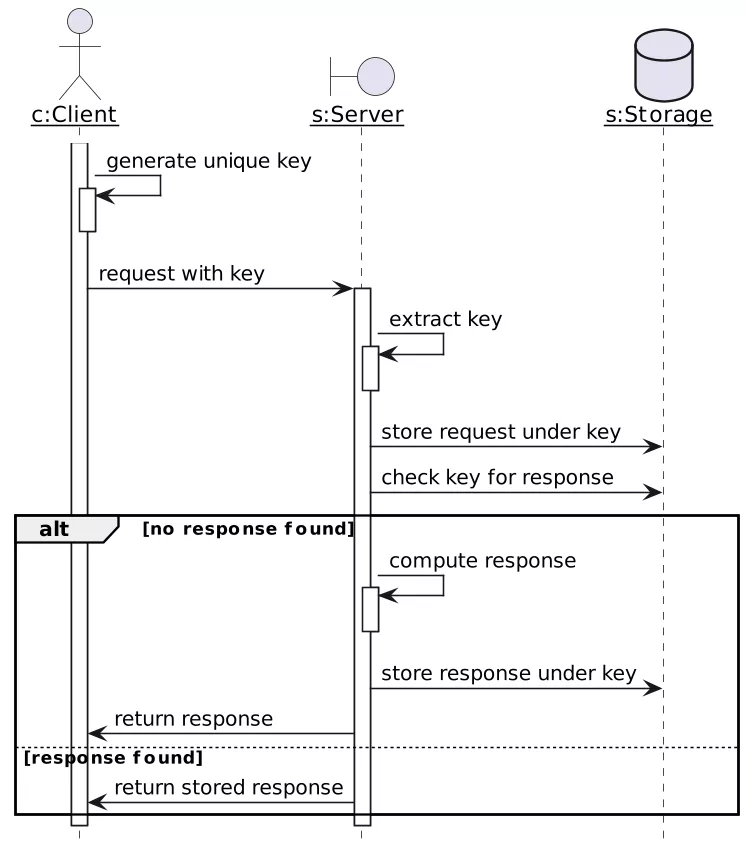The first rule of distributed systems is "Don’t distribute your system". Designing distributed systems right is infamously hard for multiple reasons.
The idempotency concept
For example, a call to a function can succeed or fail in non-distributed systems. Once you move the called function to a remote component, a third option appears: you call the remote function but get no response from the component. At this point, it’s impossible to know whether the call reached the component or not, i.e., whether the problem occurred on the way to or the way back.
The only choice is to resend the request again. It’s a non-issue for reads; for calls that update the remote state, it’s "complicated." We need to describe the concept of idempotence:
Idempotence is the property of certain operations in mathematics and computer science whereby they can be applied multiple times without changing the result beyond the initial application.
In the realm of HTTP APIs:
GET,PUT,DELETE,HEAD,OPTIONS, andTRACEare idempotent. For example, if you repeatedly delete an entity from the system, whether the said entity exists or not, the end state will be the same: there will be no entity.POSTandPATCHare not idempotent. For example, posting multiple times a new entity will create that many new entities.
A possible solution
Imagine that the client sending a request sends a unique key along. The server keeps track of key-request pairs. Overall, two things can happen:
- The server already has a record of such a pair and discards the request
- The server has no such previous record and stores the pair
It’s precisely the idea behind the IETF specification The Idempotency-Key HTTP Header Field. The Idempotency-Key HTTP header’s value is a string; the specification uses a UUID as an example. It’s the client’s responsibility to generate such a value, which must be unique.
The spec describes the following flow:

The specification mentions the server can optionally fingerprint the request, i.e., hash it, and store the hash instead.
Error scenarios
The nominal path is pretty straightforward, but the specification also defines three possible error scenarios that can happen.
Here they are:
The request doesn't provide the idempotency key for a documented idempotent operation requiring this header/400:
HTTP/1.1 400 Bad Request
Content-Type: application/problem+json
Content-Language: en
{
"type": "https://developer.example.com/idempotency",
"title": "Idempotency-Key is missing",
"detail": "This operation is idempotent and it requires correct usage of Idempotency Key.",
}Attempt to reuse an idempotency key with a different request payload/422:
HTTP/1.1 422 Unprocessable Content
Content-Type: application/problem+json
Content-Language: en
{
"type": "https://developer.example.com/idempotency",
"title": "Idempotency-Key is already used",
"detail": "This operation is idempotent and it requires
correct usage of Idempotency Key. Idempotency Key MUST not be
reused across different payloads of this operation.",
}Request is retried while the original request is still being processed/409:
HTTP/1.1 409 Conflict
Content-Type: application/problem+json
Content-Language: en
{
"type": "https://developer.example.com/idempotency",
"title": "A request is outstanding for this Idempotency-Key",
"detail": "A request with the same Idempotency-Key for the
same operation is being processed or is outstanding."
}
Conclusion
Distributed systems are complex in part because if a call to a remote component times out, it’s impossible to know whether it reached the said component. The only option is to repeat the call, but we risk executing a non-idempotent operation twice. In the realm of APIs, we can rely on the Idempotency-Key HTTP Header, an IETF specification currently in draft.
From an architect’s point of view, it makes sense to factor the behavior described in the above sequence diagram into a component, i.e., an API Gateway. In a future post, I’ll try implementing the behavior in Apache APISIX.
To go further:
